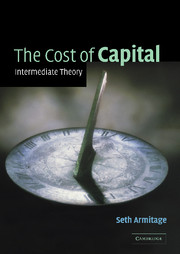Preface
Published online by Cambridge University Press: 05 June 2012
Summary
All companies and investment projects need capital (money tied up in the business), and capital is not a free resource. A project's cost of capital is the minimum expected rate of return the project needs to offer to attract the money required. But where does the minimum expected rate come from? This book provides an answer. It sets out to explain what the finance and economics literature says about how a project's cost of capital is determined and estimated. It is written primarily for people who have already done some academic finance, accounting or economics but who are not necessarily well versed in the topics covered. In other words, it acts as a bridge between a general undergraduate or MBA text in finance, accounting or economics and the body of knowledge that relates to the cost of capital. It is suitable for students at honours, M.Sc. or MBA level who will have encountered the concept and who wish to know more.
Ease of comprehension is a high priority. Much of the book consists of explanations of theories, and many of the theories are demanding. I have done my best to present each model or argument in a way in which it can most easily be understood, whilst giving enough detail for the reader to see how a conclusion has been arrived at. The text includes plenty of discussion, supported by numerical examples. The exposition is in discrete time and uses (almost) no matrix notation.
- Type
- Chapter
- Information
- The Cost of CapitalIntermediate Theory, pp. xiii - xviPublisher: Cambridge University PressPrint publication year: 2005

